During the Victorian age local cemeteries were becoming increasingly overcrowded, with burials taking place on top of former burials. Horror stories abounded: gravediggers jumping up and down on old corpses to fit new ones in; the cutting through of mistakenly exhumed limbs whilst digging new plots; accidentally digging so deep that corpses fell into the sewers and were flushed away. The Victorians believed that the rot and mildew caused by these unsavoury actions led to miasma (bad air) which was considered very unhygienic and the transmitter of disease.
In London this crisis led to the creation of the 'Magnificent Seven'. The term refers to the seven large, private London cemeteries which were established in the 19th century to alleviate overcrowding in parish burial grounds. They are:-
Brompton Cemetery is in the Royal Borough of Kensington and Chelsea and is the only cemetery in the country to be managed by the Crown.
When Little Miss Macabre, Gothic and Ghoulish heard about an open day, advertised by someone on Facebook, she just couldn't resist the chance to go dance with the dead. It took place on a very clammy day at the end of July.
It was a painless journey from my home in east London to Earl's Court, but I did have another of those 'why couldn't I have done this when I lived nearby?' (I've lived in both Hammersmith and Fulham) moments.
Here is the imposing main entrance.
Behind this gate is the cafe and a shop, where you can buy books and see pamphlets relating to the cemetery. I didn't hang around as I needed to get down to the chapel to book my tour. I was told that they sell out fast...
In London this crisis led to the creation of the 'Magnificent Seven'. The term refers to the seven large, private London cemeteries which were established in the 19th century to alleviate overcrowding in parish burial grounds. They are:-
Kensal Green Cemetery (1833)
West Norwood Cemetery (1836)
Highgate Cemetery (1839)
Abney Park Cemetery (1840)
Nunhead Cemetery (1840)
Brompton Cemetery (1840)
Tower Hamlets Cemetery (1841)
Brompton Cemetery is in the Royal Borough of Kensington and Chelsea and is the only cemetery in the country to be managed by the Crown.
When Little Miss Macabre, Gothic and Ghoulish heard about an open day, advertised by someone on Facebook, she just couldn't resist the chance to go dance with the dead. It took place on a very clammy day at the end of July.
It was a painless journey from my home in east London to Earl's Court, but I did have another of those 'why couldn't I have done this when I lived nearby?' (I've lived in both Hammersmith and Fulham) moments.
Here is the imposing main entrance.
Behind this gate is the cafe and a shop, where you can buy books and see pamphlets relating to the cemetery. I didn't hang around as I needed to get down to the chapel to book my tour. I was told that they sell out fast...
This is a PDF of a map showing the layout of the cemetery...
My first impression is that this was a cemetery which was very easy to navigate, being uniform in layout and quite small in comparison to both Highgate Cemetery and Kensal Green Cemetery, which I've also visited.
I would say that Highgate is more evocative and mysterious, although that might have something to do with the fact that the west side of it is only accessible via a tour, so comes across as a bit secret, forbidden and special.
Here is my blog about it:-
I did overhear a guide mention that 'we don't have lots of famous people here' and she had a point. There are nothing like the amount of well-known figures you will find if you venture up to Kensal Green Cemetery, which has been described as 'a Who's Who of fashionable 19th century society'.
Read all about my visit here:-
Back to Brompton Cemetery and this was the view down Central Avenue, which splices the cemetery in half lengthways.
The sky might have been moody, but the day was WARM, and then some. You can see a selection of stalls set up at the end. These displayed foodstuffs such as jams, biscuits and cakes and items such as jewellery, luxury toiletries and secondhand books.
Three chapels were planned but only this one was built. It is still used for funeral services as well as other activities and events. The eight-sided building is supposed to represent life on earth.
There was a display of local artistry inside....
Its lofty interior is certainly beautiful and impressive...
There was a display of birds of prey...
...And this little chap was my favourite. There was a bucket requesting donations if you took a photo, but I didn't have change and wasn't going to sling a tenner in. I meant to go back once I'd acquired some coinage- but I forgot. Oops!
The vintage hearse. There was also an undertaker floating around, in period costume, but unfortunately I didn't get a snap of him.
The hearse from the side. The undertaker wasn't the only person in costume- the day brought forth a smattering of goths whom I pitied- their style of dark, gloomy, corseted dress (which I rather like💜) was really too hot and restrictive for this particular day.
I signed up for a catacombs tour. They lasted half and hour and only cost a fiver. You can also sign up for a cemetery tour, but I wanted to do this at my own pace.
The catacombs we saw are underneath the Great Circle and these are the steps down.
Symbolism abounds on the door, with the downward-facing torches representing a life snuffed out, and the serpent catching its tail the ring of everlasting life.
There is room for thousands of burials down here, but only 500 spaces were actually sold...
The law dictated that coffins used for catacomb burials had to be encased in lead...
This is damp, and not human seepage...
Suffer from arachnophobia? Then don't venture in here. Little friends like this are everywhere...
Some relatives attached a wood casing to the outside of the lead coffin...
...Wood decays- as you can see here, where it's been reduced to powder...
Brompton Cemetery offered a range of interments when it opened, with budgets to suit every pocket...
Relatives thought a catacombs burial would be cheaper that erecting a stone monument outside...
But, by the time they'd had to fork out for a lead-encased coffin, and then encased that in wood, then it worked out as just as expensive!
Victorian relatives thought that a catacomb burial meant that they could be closer to their loved ones, visiting the coffin regularly...
But Kensal Green Cemetery, with its magnificent catacombs proved to be more popular.
Some dates on plaques are visible, such as this chap, who left this mortal coil in 1874...
It clearly states that he fought in the 1815 Battle of Waterloo.
Over time, there was a growing interest in cremation, which was thought to be more sanitary...
Plus gruesome tales abounded, such as the public health warning of lead coffins exploding due to the build up of gases released by the decomposing bodies!
Staring down into the section we were not allowed to walk into...
Some coffins were placed behind bars...
...Some were situated sideways, and some lengthways...
Wasted, unsold space...
The dark end of the curving catacombs. They don't join the colonnade next to it, which has its own entrance.
It was a privilege to visit the catacombs, which are rarely open to the public.
Back up into the light and the walkways around the Great Circle make for a picturesque stroll...
The Colonnades. On the walls are intermittent memorial plaques...
Looking from one part of the Great Circle to its mirror image...
Glancing out over the tombstones...
It's not a bad place in which to spend eternity...
I liked these l-o-n-g photographs that seem to sweep off, almost into infinity...
...The Colonnades made for some very artistic and haunting shots...
Looking from one side of Central Avenue to the next. The stairs lead down into the catacombs, which are under all of the colonnades, as well as being housed in a building of their own to the west of the cemetery.
This colonnade end reminded me of a Roman temple...
Crossing over to the other side. (No, not THAT 'other side'!)
The view over the dead and to the chapel.
Snaking round...
Looking back and Central Avenue continues towards the main entrance I used (there is another at the back of the cemetery) from the gap in the Colonnades (almost obscured here by a monument.)
This was one of my favourite shots, featuring both the walkway and chapel. You can also see some of the stalls.
To the side of the central section the cemetery is definitely more desolate and unkempt, with some headstones peeking upwards like teeth...
...And some grand old trees with overgrown graves popping up near their base...
I liked this particular tree, which I believe is a yew tree. Stare hard and you can see the red flesh around the seeds sprouting on the branches. Yew trees are a symbol of everlasting life.
Stamford Bridge football ground is the home of Chelsea Football Club. It was founded in 1905 by Gus Mears, who is buried in the cemetery. Useless fact:- one thing I did do when I lived in Fulham is pop into the The Shed for a pint. It is the bar inside the football stadium (I would!)
The Western Catacombs line the wall of the cemetery and were firmly locked against nosey parkers like myself...
I had a peek in, but there wasn't much of any significance to see...
Looking through the wilderness towards the end of the Colonnades...
The Western Catacombs fall away to reveal just a wall. This section looks a bit more tended, with a few pretty bushes and less chaos.
I then went off in search of the graves of famous people. Some I had earmarked, and some I just stumbled across (I think you'll be able to guess which ones I targeted as being of special interest to me as I've had much more to say about them.)
Henry Augustus Mears (1873-1912), known as Gus, founded Chelsea Football Club. The stadium is right next to the graveyard and can be seen from the far corner.
John Bonomi the Younger (1796-1878) started out as a sculptor but became a notable artist, travelling to Egypt to draw the ancient temples and pyramids there. He learnt Arabic and wore local dress, immersing himself in the culture. On his return to England he helped arrange the British Museum's Egyptian exhibits and went on to design several Egyptian style buildings.
Hannah Courtoy (1784-1878) was a mysterious society lady with a fabulous wealth. She led a controversial life, never marrying merchant John Courtoy (who was much older than she was) despite having three daughters with him. She inherited his fortune and lies beneath this Egyptian-inspired tomb. Some believed that the pharaohs knew about time travel and teleportation, and does this include those who studied the pyramids and tombs, such as Egyptologist Joseph Bonomi (who helped design her tomb and who lies only a few metres away)? So, the question remains:- is this mysterious mausoleum in actual fact a time-travelling Tardis?
Children's author Beatrix Potter lived nearby and it's believed that she used to take walks through the cemetery, to contemplate. She is alleged to have taken the names of some of her much-loved characters from gravestones. Mr Nutkins features in her work, so could he have come from this family grave? Mr Rabbett, Mr Fisher, Mr Brock and Mr McGregor have all been found in the cemetery.
Princess Victoria Gouramma (1841-1864) was an exiled Indian royal who was 'adopted' by Queen Victoria. She converted to Christianity, became an honorary princess and was often seen out and about with the royal family.
Her grave was not easy to find. Despite having it marked on my map- and with a picture on my phone as a visual reference- it remained elusive. That is, until I stumbled upon a tour group right nearby, caught the name of the lady in question and gatecrashed the party.
A cross once sat on the top of the headstone but has long since broken off. According to the guide, Queen Victoria paid for Gouramma's funeral.
Marchesa Luisa Casati (1881-1957) was an Italian heiress, patroness of the arts in early 20th century Europe, an exuberant dresser and a muse. Considered to be the Lady Gaga of her day, she led an extravagant lifestyle and used to parade around with a pair of leashed cheetahs whilst wearing live snakes as jewellery! Known for inserting belladonna into her eyes (a dangerous practice; used to make the pupils enlarge, therefore creating a seductive effect) and outlining them with kohl, I just HAD to find where this lady rested.
She died nearby, in poverty, having amassed a debt of $25 million. She was often seen rummaging in bins, apparently for feathers with which to decorate her hair and was buried in her leopard skin finery with her false eyelashes in place. Something of a gay icon, regular pilgrimages to her grave occur.
You can see her picture propped against the tombstone, as well as a multicoloured brooch that has been left as a tribute.
Sir Robert Rawlinson (1812-1898) was a civil and sanitary engineer.
Dr Benjamin Golding (1793-1863) was the founder of the Charing Cross Hospital.
Emmeline Pankhurst (1852-1928) was the leader of the British suffragette movement, whose campaigning (often using controversial methods) led to women being given the vote. She is considered to be one of the most important people of the 20th century, and us modern gals have a lot to thank her for.
Dr John Snow (1813-1858) has been voted the greatest physician of all time by British doctors. A leader in the development of anaesthesia and medical hygiene, he is considered to be the father of modern epidemiology. He proved that cholera was caused by drinking infected water and was so highly regarded that Queen Victoria allowed him to administer chloroform to her during the births of her last two children, Prince Leoplold and Princess Beatrice.
Here's a selection of random tombs which caught my eye. The wealthier you were then the bigger your tomb and the closer you were placed to the front of Central Avenue.
This monument has a cracked, crazy paving effect.
I'm assuming that stacked cannonballs indicated a military background (they are also by The Brigade of Guards Monument). This guy is noted as having served in the Royal Marines.
These are two 'putti' (winged children) sprinkling flowers onto the grave. This was my favourite monument.
I love the 'knobbly' cross to the right of the picture...
Tall angels and crosses...
Lonely monument, off to the east side of the cemetery...
Mausoleum with an angel gesturing to heaven...
Two views of the same 'mini-church', which was another eye-catching monument...
Obelisks were popular in cemeteries dating from the 1840s as they were considered tasteful- with clean uplifting lines- and were associated with greatness. They take up a relatively small amount of room and were (perhaps most importantly) cheaper to produce than elaborate monuments.
An imposing and very aesthetically pleasing tomb...
A traditional, solid monolith...
Twisty column...
Some graves are just old and broken, such as this angel, who appears to be taking a rest...
This urn has finally given up the ghost and collapsed...
I took this picture as I thought it looked fun! I don't know what material this gravestone was made of, but it was put in place for our entertainment on this open day.😄
The Brigade of Guards Monument marks the burial place of hundreds of peacetime casualties from 1854 to 1899. The three earliest regiments of guards were the Coldstream, Grenadier and Scots Guards. The Brigade of Guards was established in 1856 to administer the British Army's guards regiments, which nowadays includes the Welsh and Irish Guards.
The Chelsea Pensioners Monument was erected in 1901. The red-coated Chelsea Pensioners are all veteran soldiers who have collectively served in every part of the world. This monument stands as a tribute to their valour, devotion, suffering and endurance.
Brompton was closed to burials between 1952 and 1966- except for family interments- but there is still the option to rest for eternity here, in this peaceful Garden of Remembrance.
Nowadays, cremated remains can be deposited here...
The most touching memorial was this canine monument guarding the resting place of a ten-year-old boy. His little plaque brought a tear to my eye and I'm assuming that the dog was his beloved pet...😢
After I left the cemetery I took a short wander down the road to Coleherne Court, made famous during 1980/1981 as the residence of Lady Diana Spencer. Back in those days the road would have been teaming with photographers, waiting to snap the woman they believed would become our future queen.
I always liked her. She didn't deserve what she ended up with.😢
TTFN
The Miss Elaineous
XXXXXXXXXXXXXXXX
XXXX
X









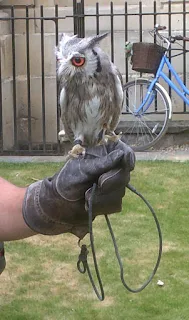



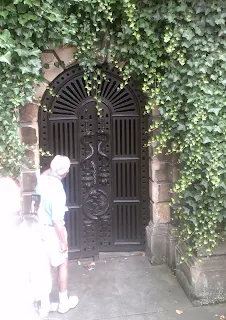


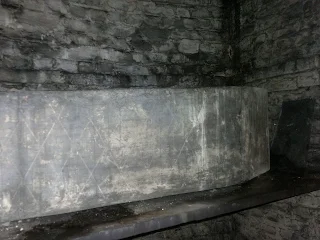






















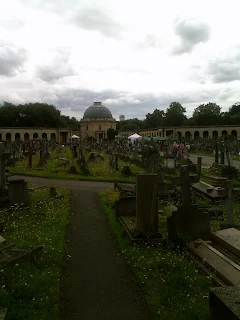





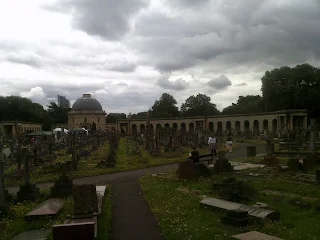























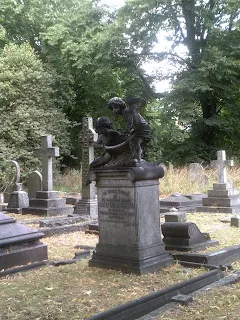



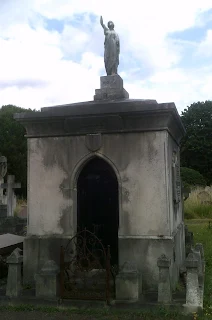














No comments:
Post a Comment